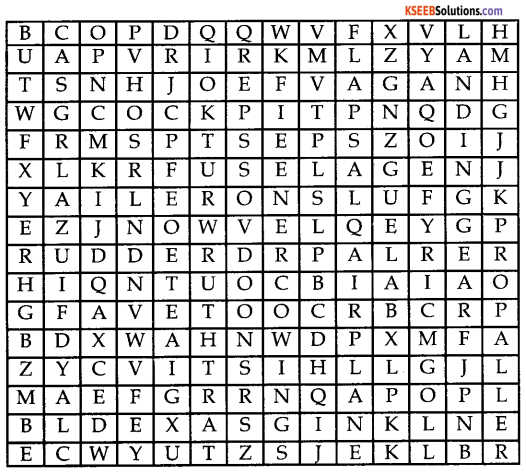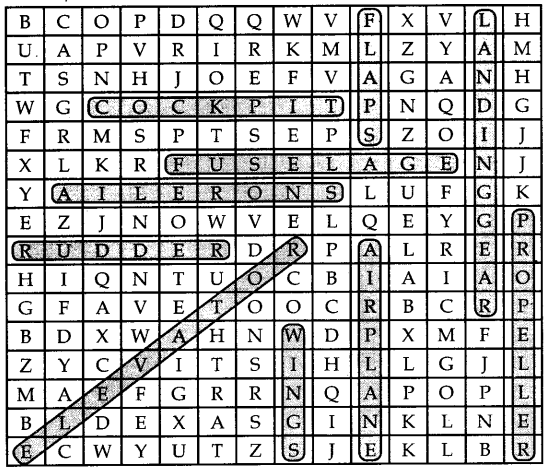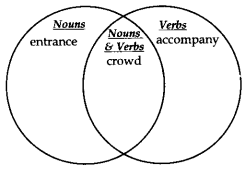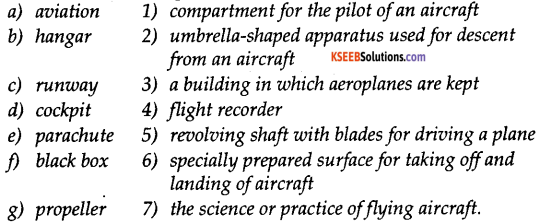By understanding the academic needs we have prepared the Karnataka State Board English Class 9 Solutions Chapter Wise. Our aim is to help the students by providing the question and answers chapter wise and help them to gain a good score in the exams. Before you start your preparation go through the chapters covered in this academic. So go through them and Download KSEEB Solutions for Class 9 English Prose Chapter 10 A Dream of Flight Question and Answers Pdf for free.
Karnataka State Board Class 9 English Prose Chapter 10 A Dream of Flight
The topics covered in Karnataka Secondary Education Examination Board Class 9 Solutions for English Chapter 10 A Dream of Flight. The KSEEB Solutions Class 9 English Solutions Chapter 10 A Dream of Flight Question and Answers are prepared according to the latest edition.The Chapterwise page will help the students to revise the syllabus during the exams.
A Dream of Flight Questions and Answers, Summary, Notes
Comprehension:
C1. Get into pairs/groups and discuss the answers to the following questions:
Question 1.
Which book took the author into ‘a dream of flight’?
Answer:
The book ‘The Invention of the Aeroplane 1799-1909’ written by Charles H. Gibbs Smith took the author into a dream of flight.
Question 2.
When did the author find the book?
Answer:
The author found the book in an old book shop just two days before.
![]()
Question 3.
What did the book explain?
Answer:
The book explained man’s never-ending longing and hope of flying that led to innumerable trials, most of which ended as disasters. The book also covered the subsequent experimentation arising from various inventions used for flight before the advent of the present-day aeroplane.
Question 4.
How was the bird man dressed to fly?
Answer:
The bird man tried to resemble a bird. He had tied himself with bat-like wings made from wood and cloth, covered with bird’s feathers.
Question 5.
What happened to the bird man when he jumped from the tower?
Answer:
A tragedy took place when the bird man jumped from the tower. Instead of flying free in the sky like a bird, he tumbled down inverted and totally out of control and crashed to the ground and died.
Question 6.
Who were the first aerial passengers?
Answer:
The first aerial passengers were animals and not human beings. As no one knew what would be the outcome of the experiment, human lives couldn’t be risked. A sheep, a hen and a duck were placed in the basket.
C2. Answer the following questions:
Question 1.
Describe the balloon in which the first aerial passengers flew.
Answer:
The balloon in which the first aerial passengers flew was a huge fabric envelope which resembled a globe in its shape. It was decorated with colourful motifs with an open bottom. There was fire arranged below so that the hot air produced by the flames filled the globe. Once the sphere was thus filled, the ropes which held it down was to be cut off simultaneously by four people who had hitherto held it down. The spherical balloon would then fly upwards and drift across the sky. In the basket of such a balloon were placed a sheep, a hen and a duck – the first aerial passengers.
Question 2.
How did Otto Lilienthal make an attempt to fly?
Answer:
In 1891 A.D., Otto Lilienthal prepared a strange craft built from wood and fabric. He brought it out of a shed built atop a big hill. This comprised two 6 m long bat-like wings on top of one another with a horizontal and a vertical surface behind. This craft also had a ring shaped frame between the wings. Lilienthal stepped inside the frame and with his arms supporting the ring, ran forward. Within a few steps, Lilienthal’s craft started floating in the air. Hanging beneath, Lilienthal glided for a long distance and touched down at the bottom of the hill.
![]()
Question 3.
How has the author described Orville Wright’s flight into the air?
Answer:
It was in 1903 that the Wright brothers invented a two¬winged machine which stood on a long wooden rafter. They took it to Kitty Hawk dunes in North Carolina. Orville Wright lay flat in the middle over the bottom wing. There was a small internal combustion engine by his side which turned a pair of two-bladed paddle wheels through long bicycle chains.
As the engine started working, Wilbur Wright freed the rope holding the machine and it surged forward. Moving at about 12 miles per hour, it suddenly lifted up and started flying in the air. This turned out to be the prototype for all aeroplane models to follow.
C3. Answer the following questions:
Question 1.
‘Man had at last devised a contraption with which he could launch himself from a hill and glide down to the ground’.
- Who had made this contraption?
- How did it work?
Answer:
- Sir George Cayley had made this contraption.
- Sir George Cayley put his carriage chauffeur inside and gave a big push. The vehicle started rolling on its wheels and rushed towards the valley below. But when it gathered speed it started floating in the air. It touched down on the other side of the valley.
Question 2.
List out the persons from the lesson who made brave attempts to fly.
Answer:
- In 1496 A.D., many men attempted to fly by tying wings on their cloth. But they could not succeed. Unfortunately, all these adventurers met with a tragic end.
- In 1783 A.D., three animals – a sheep, a hen and a duck were sent in a hot air balloon in France.
- In 1853 A.D., Sir George Cayley built a contraption which floated for some time before touching down.
- In 1891 A.D., Otto Lilienthal built a glider successfully.
- In 1903 A.D., the Wright Brothers built a machine which flew for a while.
Thus, finally man was successful in his attempts to fly.
Question 3.
What does the lesson inspire you to do?
Answer:
The lesson ‘A Dream of Flight’ inspires us to hitch our wagons to a star, that is, set high goals. It shows that nothing is impossible if we dream till our dreams turn themselves into thoughts and thoughts into actions.
Additional Questions:
Question 1.
Who was the author of the book, ‘The Invention of the Aeroplane 1799-1909’?
Answer:
Charles H. Gibbs Smith.
Question 2.
How did the contraption devised by Sir George Cayley start?
Answer:
When Sir George Cayley gave a push to the contraption, at first it started rolling on its wheels and rushed towards the valley below. But as it gathered speed, it lifted off the ground, went floating in the air and touched down on the other side of the valley.
![]()
Question 3.
Name the Wright brothers.
Answer:
Orville and Wilbur Wright.
Question 4.
Which book was the author K.S. Raman reading? What effect did the book have on the author?
Answer:
The author was reading the book called, ‘The Invention of the Aeroplane 1799-1909’. The author was so engrossed in the book that he even missed his regular evening walk. To complete the book he read it until past midnight. It left him exhausted.
The events from the book were very fresh in his mind. As he gradually drifted off to sleep, he entered a dream world of the evolution of aeroplanes. He could almost feel the tension and excitement of flying. Then he started seeing the important events in the history of flight in his dream.
Multiple Choice Questions:
Question 1.
The author found the book ‘The Invention of the Aeroplane 1799-1909’ in
A) his library
B) the public library
C) an old book shop
D) his friend’s house.
Answer:
C) an old book shop
Question 2.
The author of the book ‘The Invention of the Aeroplane 1799-1909’was
A) K.S. Raman
B) Sir George Cayley
C) Orville Wright
D) Charles H. Gibbs Smith.
Answer:
D) Charles H. Gibbs Smith.
Question 3.
The author was so absorbed in the book that he even forgot
A) his morning walk
B) his breakfast
C) his evening walk
D) his dinner.
Answer:
C) his evening walk
Question 4.
After reading the book the author dreamt of
A) people and their attempts to fly
B) his flight to a foreign country
C) an aeroplane
D) piloting a plane.
Answer:
A) people and their attempts to fly
![]()
Question 5.
The Bird Man made his attempt to fly in the year
A) 1783 A.D.
B) 1853 A.D.
C) 1496 A.D.
D) 1891 A.D.
Answer:
C) 1496 A.D.
Question 6.
In the year 1783 A.D., ……….. was invented.
A) glider
B) aeroplane
C) hot air balloon
D) helicopter.
Answer:
C) hot air balloon
Question 7.
Sir George Cayley invented a contraption in 1853 A.D. that could
A) fly in the air
B) carry passengers
C) launch a man and glide down to the ground
D) soar into the sky.
Answer:
C) launch a man and glide down to the ground
Question 8.
The first aeroplane was invented by
A) The Bird Man
B) Otto Lilienthal
C) The Wright brothers
D) Sir George Cayley.
Answer:
C) The Wright brothers
Question 9.
…………. were the first air passengers.
A) A sheep, a hen and a duck
B) A cow, a sheep and a hen
C) A sheep, a duck and a dog
D) A cat, a dog and a duck.
Answer:
A) A sheep, a hen and a duck
Question 10.
Sir George Cayley put his ………….. inside the contraption with wheels devised by him.
A) cook
B) dog
C) chauffeur
D) duck.
Answer:
C) chauffeur
Question 11.
The craft of Lilienthal comprised of two 6 m long …………… like wings.
A) crow
B) bat
C) eagle
D) crane.
Answer:
B) bat
Language Activities:
A) Vocabulary:
V1. The grid contains some of the words you come across in the lesson and other words related to airplane. Find these words:
- Propeller
- Cockpit
- Fuselage
- Ailerons
- Rudder
- Elevator
- Wings
- Airplane
- Flaps
- Landing gear

Answer:

![]()
V2. Here are some words. Some of them are nouns and some are verbs and others can be used as both nouns and verbs. Work in pairs/groups and put them in the diagram as shown in the example.
- entrance,
- support,
- chair,
- fish,
- crowd,
- treatment,
- accompany,
- street,
- thank,
- garden.

Answer:

V3. Complete the table with appropriate forms of the words:
| SI.No. | Words | Noun | Adjective | Verb | Adverb |
| 1. | secure | ||||
| 2. | loose | ||||
| 3. | thank | ||||
| 4. | conversation | ||||
| 5. | move |
Answer:
| SI.No | Words | Noun | Adjective | Verb | Adverb |
| 1. | secure | security | secure | secure | securely |
| 2. | loose | looseness | loose | loosen | loosely |
| 3. | thank | thankfulness | thankful | thank | thankfully |
| 4. | conversation | conversation | conversational | converse | conversationally |
| 5. | move | move, movement | movable, moving | move | movingly |
V4. Semantic mapping:
Write four words that belong to the same semantic field for the words given below:


Answer:

V5. Prefixes and Suffixes
| Suffix | Meaning | Example | Your example |
| -er/or | a person | player, teacher | |
| -ful | full of | helpful, needful | |
| -logy | subject of study | psychology, biology | |
| -less | without | fearless, endless | |
| -iy | makes an adverb from an adjective | cheaply, slowly |
Answer:
| Suffix | Meaning | Example | Your example |
| -er / or | a person | player, teacher | Banker, financier, actor |
| -ful | full of | helpful, needful | Playful, careful |
| -logy | subject of study | psychology, biology | Zoology, Sociology |
| -less | without | fearless, endless | Mindless, clueless |
| -ly | makes an adverb from an adjective | cheaply, slowly | Kindly, carefully |
![]()
B) Grammar And Usage:
G1. Change the following sentences into passive voice:
- My parents give me some pocket money.
Some pocket money is given to me by my parents. - The Mayor promised new houses to people.
New houses were promised to people by the Mayor.
People were promised new houses by the Mayor. - The school declared a holiday.
A holiday was declared by the school. - I gave the baby a doll.
A doll was given by me to the baby.
The baby was given a doll by me. - They offered me a better job.
I was offered a better job by them.
A better job was offered to me by them.
G2. Read the following passage and change into passive voice:
A few days ago, somebody stole Ravi’s motorbike. Ravi had left his motorbike outside his house. Ravi reported to the police. The police had told him they would try to find his motorbike. This morning the police called Ravi and asked him to come to the police station. They had found his motorbike. The thieves had painted it and then sold it to someone else. The police had arrested the thieves.
Answer:
A few days ago, Ravi’s motorbike was stolen by somebody. The motorbike was left outside his house by Ravi. The matter was reported by Ravi to the police. He was told by the police that they would try to find his motorbike. That morning Ravi was called by the police and was asked to come to the police station. The motorbike was found by them. It was painted by the thieves and was sold to someone else. The thieves were arrested by the police.
G3. Read the following paragraphs and underline the sentences in passive voice:
There have been many attempts at developing a modem snowboard. In 1965, the ‘Snuffer’ (a wordplay on ‘snow’ and ‘surfer’) was developed as a child’s toy. Two skis were bound together and a rope was placed at the front end to afford control and stability. Over 500,000 ‘Snuffers’ were sold in 1966 but they were never seen as more than a child’s plaything even though organized competitions began to take place. The year 1969 brought a slightly more sophisticated snowboard based on the principles of skiing combined with surfboard styling.
The ‘Flying Yellow Banana’ was developed in 1977. This was nothing more than a plastic shell covered with a top surface like that of a skateboard, but at the time it was considered a major advance in the little known sport of snowboarding. The first national snowboard race was held in the area outside Woodstock and was known as ‘The Suicide Six’. The race consisted of a steep downhill run called ‘The Face’ in which the main goal was probably mere survival.
Answer:
There have been many attempts at developing a modern snowboard. In 1965, the ‘Snurfer’ (a wordplay on ‘snow’ and ‘surfer’l was developed as a child’s toy. Two skis were bound together and a rope was placed at the front end to afford control and stability. Over 500,000 ‘Snurfers’ were sold in 1966 but they were never seen as more than a child’s plaything even though organized competitions began to take place. The year 1969 brought a slightly more sophisticated snowboard based on the principles of skiing combined with surfboard styling.
The Flying Yellow Banana’ was developed in 1977. This was nothing more than a plastic shell covered with a top surface like that of a skateboard, but at the time it was considered a major advance in the little known sport of snowboarding. The first national snowboard race was held in the area outside Woodstock and was known as ‘The Suicide Six’. The race consisted of a steep downhill run called ‘The Face’ in which the main goal was probably mere survival.
![]()
Listening & Speaking:
A) Listening Skill:
L1. Read the passage and answer the questions that follow:
The late 1800s ushered in a huge bicycle boom, and people began to experiment with bicycle shapes and styles to suit the varying needs of the rider. In the last decade of the 19th century, people focused on the changes and improvements they made on what they thought bicycle riders wanted or required. Despite a varying degree of styles and models, four major focuses stood out from the rest: speed, safety, comfort, and endurance.
Many materials were experimented in making bicycle. Wood was used in most early models, but then people began fashioning bikes out of metal. The very first automobile was a tricycle that put a steam engine to use. Sewing machine factories had the equipment and skills to build bicycles, so some companies made the shift to this new, promising business. The 1890s was known as the decade of the bicycle.
Once prices became reasonable for most people (under $100 for a good bike), a social revolution occurred. Doctors and lawyers became indistinguishable from shopkeepers and tradesmen when they were all riding in uniform with their bicycle clubs. Young people found themselves able to pedal beyond their own neighborhoods, and a generation of women traded in their corsets for bloomers to make for easier riding.
Question 1.
When did the bicycle boom begin?
Answer:
A) early 1800’s
B) late 1800’s
C) early 1900’s
D) late 1900’s.
Answer:
B) late 1800’s
Question 2.
Which of the following was NOT a major influence on the evolution of the bicycle?
A) Speed
B) Safety
C) Comfort
D) Style.
Answer:
D) Style.
Question 3.
What material were the first bicycles made from?
A) Iron
B) Aluminium
C) Wood
D) Steel.
Answer:
C) Wood
Question 4.
What kind of wheeled vehicle was the automobile first made from?
A) Tricycle
B) Quadruplet
C) Bicycle
D) Tandem.
Answer:
A) Tricycle
Question 5.
What factories had the equipment and skills to build bicycles in the late 1800’s?
A) Steel factories
B) Wagon factories
C) Wind mill factories
D) Sewing machine factories.
Answer:
D) Sewing machine factories.
Question 6.
What promoted the social revolution in the 1890’s?
Answer:
A) Bicycles were reasonably priced for most people.
B) Difficult to distinguish upper and middle class when wearing bicycle uniforms
C) Young people were able to travel beyond their neighbourhoods.
D) All of the above.
Answer:
D) All of the above.
B) Speaking Activity:
S1. Write a sentence for each of the following situations ‘asking for information’.
- Asking the station master the fare from Hubli to Mysore. May I know the fare from Hubli to Mysore?
- Asking the way to Vidhana Soudha.
Could you please tell me how to reach Vidhana Soudha? - Asking permission to read a book.
Sorry to disturb you, but could I please read a book? - Requesting to have a bike ride.
Excuse me, do you mind giving me a ride on your bike? - Asking your mother for pocket money.
Mom, would you mind giving me some pocket money?
![]()
Writing Skill:
I. Write a paragraph on “Success comes to those who dare and act” using the hints given below:
- Think of a person who has performed a daring feat.
- List out the difficulties experienced by that person.
- How did he/she overcome the difficulties?
- What is the secret of his/her success?
- List out the admirable qualities.
Answer:
Success comes to those who dare and act:
Most of us are curbed by the fear of failure and fall short of trying out many interesting things in life. But there are a few who are daring in spirit and they venture into uncharted paths. Their spirit of adventure keeps them alive and they turn out to be successful people. One such daring person is my cousin Rakesh who gave up his secure IT profession to try out something his heart prompted him to do.
After witnessing the plight of the old people, who find it very difficult to manage their lives and homes, he started an organisation called Bandhu which has skilled technicians and other workers to deal with all the needs of the aged.
Rakesh studied the demography of the city in a survey and realised that the number of old people was enough for his start up to sustain. His vision seemed to be right. All those who have gone away from their old parents to distant places for various purposes find a lot of assistance in Bandhu. Rakesh also has a philanthropic scheme.
He has a fund which has donations from those who are financially well off and if a few families find it difficult to make payment, the deficit is made up by utilising the money from this fund. However, no service is entirely free of charge as Rakesh knows that the services will be misused by many if they were to be totally free.
It is not that everything was a smooth go for Rakesh. In the beginning, the income was so low that he had to use up all his savings for the rent, salary and maintenance. But he had the perseverance and did not lose courage. Finally, what we can say about Rakesh is that he had the vision to understand the need of the hour.
He now plans to extend the service of Bandhu to whoever is in need in the city though it means increasing the number of employees three times. Rakesh says that his ultimate goal is to make Bandhu a chain of helplines throughout the state. With his clarity of thought and grit, he is sure to succeed.
A Dream of Flight by K.S.Raman About The Author:
K.S. Raman (1955-2003), an aeronautical engineer by profession, his interests encompassed the faculties of aerospace, automobiles, architecture, photography, music, culture and history. He was a senior scientist at National Aerospace Laboratories (NAL) in Bangalore. With his engineering knowledge, his ingenuity and passion for aircraft and cars, and interest in model making, Raman became a self-taught painter. Some of his paintings have been exhibited abroad and have also won him medals of honour. Raman passed away in July 2003 at the young age of 46.
A Dream of Flight Summary in English
Though the title of the essay by K.S. Raman is ‘A Dream of Flight’, and though the writer himself refers to a dream, we see that the sequences that unfold are not mere dreams. They are the outcome of the creative imagination of the author who must have had many mental images. In the lesson, we see that the speaker has just finished reading the book ‘The Invention of the Aeroplane 1799-1909’ by Charles H. Gibbs Smith and is full of ideas and information that he has gathered from the book. Even as he drifts to sleep, he visualises the various stages that mark the history of aviation.
In 1496 A.D. man’s desire to fly like a bird never came to fruition. Many adventurers tried in vain to fly in the sky and, what is worse, even lost their lives while attempting to do so.
After almost three centuries, in 1783 A.D., there was success when aviation enthusiasts were able to send a huge, globular fabric envelope flying into the sky in the town of Annonay in France. A sheep, a hen and a duck placed in the basket of the balloon got the privilege of being the first air passengers.
In 1853 A.D., Sir George Cayley successfully made a boat-shaped contraption, with wheels at the bottom and a big wing, fly across a valley. What is more, Cayley put his chauffeur inside the boat-shaped contraption!
Again in 1891 A.D., Otto Lilienthal risked his own life by hanging beneath a craft that he built from wood and fabric and made it fly.
The turning point came in 1903 A.D. when the Wright brothers gave to the world its first aircraft in North Carolina. Orville Wright lay in the aircraft and Wilbur Wright manoeuvred its move.
It was after the speaker had visualised all these historic moments and pathbreaking experiments that he was woken up by the piercing sound of the alarm clock.
Glossary:
Here are some words connected with planes and flying. Do you know what they mean? Match the words with their meanings.

Answer:
a. 7
b. 3
c. 6
d. 1
e. 2
f. 4
g. 5
We hope the information prevailed in this article is helpful for all the students of Class 9. The Karnataka State Board Solutions for Class 9 English Chapter 10 A Dream of Flight Question and Answers pdf enhance your skills and score good marks in the exams. Stay tuned to get the latest information about the KSEEB Solutions Class 9 English Solutions.